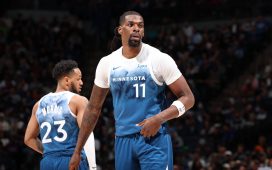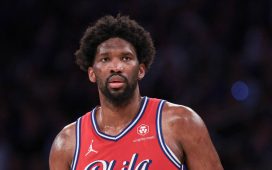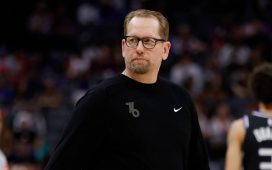LOS ANGELES — Is it real, or is it a mirage?
Whether for good or bad, that’s the biggest question every coaching staff and front office is trying to answer in the opening games of the season. All kinds of unexpected things reliably happen in the season’s first two weeks, and this year, it’s happening more than ever.
For starters, the standings are practically upside down. Entering Monday, the Thunder, Jazz, Spurs and Blazers are a combined 18-8; three of these four teams were supposed to be abjectly tanking for Victor Wembanyama. The Pacers are 3-4 and have the league’s seventh-ranked offense. Meanwhile, five alleged contenders — the Clippers, Warriors, Sixers, Heat and Nets — are a combined 11-22.
Dig deeper and the oddities only grow. Last season’s two dominant defenses, Boston and Golden State, rank 22nd and 23rd, respectively. Memphis and Miami were fourth and fifth at that end; this season, they’re 28th and 20th. Sorry, but if you want to see a top-10 defense in action, you’ll need to dial up the Jazz or Wizards.
Again, it’s still early. We’re talking about six-game samples for most of these teams. Some of the surprises can possibly be explained away by shooting luck and other forms of variance. For instance, the Nets have been disastrous, ranking last in defense in their 1-5 start, but their opponents are also shooting an unsustainable 43.8 percent on 3s; Brooklyn ranks fourth in 2-point defense. On the flip side, Charlotte’s surprising start without two key backcourt players has perhaps been greased by Jedi 3-point defense that has opponents making just 28.2 percent from deep.
Nowhere are these questions more prominent than in the City of Angels, where the Lakers and Clippers rather unexpectedly sport the league’s two worst offenses in the early going and are a combined 2-8 when not playing each other. They’ve been so brutal on offense that they rate orders of magnitude worse than even 28th-ranked Orlando. The Magic, at 107.9 points per 100 possessions, are closer to the league average than they are to the 29th-ranked Clippers’ mark of 102.2.
The Lakers’ struggles have gained so much national prominence that the Clippers’ woes haven largely spared them from the national radar; they might change their motto to “Thank God for the Lakers.” However, Sunday’s doubleheader at The Arena Formerly Known as Staples Center laid bare that the Clips’ early issues may be just as vexing as their co-tenant’s, as their moribund 112-91 defeat dropped them to 2-4.
For both teams, there’s a basic math problem at the core of their struggles. For the Lakers, it’s at least known: If nobody can shoot straight, how are they supposed to score? The Lakers are playing extremely hard (third in defense!) and generating a lot of open 3-pointers. They just can’t make any of them — a laughable 26.6 percent from 3 this season. For one night, at least, they made enough of them to score 123 points in a cathartic Sunday win over Denver, but the bigger picture issue remains. And it’s harder to write it off as an outlier when this team made 28.6 percent of its 3s in preseason.

GO DEEPER
Lakers turning point? Why Russell Westbrook and Anthony Davis are now reasons for optimism for Los Angeles
Meanwhile, the math at the heart of the Clippers’ woes (well-documented by our Law Murray) is that you can’t score if you don’t shoot, and the Clippers are losing the possession battle by staggering margins. Despite a guard-dominated roster, their 16.1 percent turnover rate ranks last by a mile.
How can a team full of jump shooters turn it over this much? Somehow, they are. The undersized Clips are also 27th in offensive rebound rate. Thus, per 100 possessions, the Clips are last in field goal attempts and second to last in free-throw attempts; it doesn’t matter what you shoot if you shoot this infrequently.
The Clippers can obviously point to the limited availability of Kawhi Leonard, but they faced that a year ago and were still nowhere near this bad.
The entire idea of the Clippers centers on the fact that they have two All-Star wings to count on and multiple quality role options behind them. So far, that hasn’t been played out. Forget All-Star: Paul George hasn’t even been average thus far. Next to him, Norman Powell and Reggie Jackson have been positively disastrous, barfing up voluminous turnovers while hunting jump shots.
Again, maybe it’s all a short-term mirage that will wash away if either team plays a more normal 10-game stretch. Or maybe it’s just who they are this season. We don’t know yet.
That’s why most smart teams strongly resist the, “Oh my, God, do something!” urge to make dramatic roster moves based on the first two weeks. We see the outlines of a pattern starting to form, but there just isn’t enough information yet.
In this case, both L.A. teams also have an underlying impatience built in based on the likely expiration dates of their star forwards’ superpowers, but two questions need answers first.
The first, obvious question is, “What do we need?” The Lakers can affirmatively answer shooting, and the Clippers might want to more real size.
But let’s suppose for a second that the weaknesses these teams have shown in the opening days of the season are real problems and aren’t going to go away. There’s still a much bigger, second question: Is this team worth saving?
For the Lakers, especially, that’s what the next 15 to 20 game are about. The oft-rumored potential trade of two future first-round picks and Russell Westbrook for Indiana’s Buddy Hield and Myles Turner is a potential option to add a lot more shooting, but how much better would it make them?
It’s not even a question of whether it moves the needle; it’s that the needle is so far to the left that it still might not matter. Is it really worth burning two potential picks to finish ninth instead of 13th? Would the Lakers rather take their medicine this season, go into the summer with those picks and a clean salary-cap slate and start anew around LeBron James and Anthony Davis? The narrative thus far has been that the Lakers’ slow start makes them more likely to make an Indiana-type trade, but I’d argue their start is problematic enough that it could make them much less likely to chase 2022-23 wins with future capital.
(Side note for those of you encouraging these teams to tank: Both the Lakers and Clippers owe pick swaps from previous trades. Not happening.)
And so we wait and watch. Not just in L.A., but in Brooklyn and Miami and Philadelphia and Golden State. At some point, these teams will have enough of a game sample size to definitively declare their early weaknesses a problem, and if so, to determine whether their rosters are worth reinforcing via the trade market.
We aren’t there yet. Informally, many front offices use the 20-game mark as a reality check on where they stand, which is still nearly a month away. In Los Angeles, especially, these will be a nervous few weeks of information gathering.

LeBron James and the Lakers finally picked up their first win of the season Sunday against Denver. (Bruce Kluckhohn / USA Today)
Cap Geekery: Rookie contract options
Most of the decision-making process for front offices is done for a while once the season starts, but one piece of business remains to be completed on Halloween.
It’s the last day for teams to pick up the third- and fourth-year options on the rookie contracts of first-rounders who were signed in 2020 and 2021. What makes it a somewhat ghoulish decision (sorry) is that teams have to decide a year ahead of time on an option for next year, with basically a full season to play out in between.
Teams who decline the option are capped on what they can offer the player in free agency (it can’t be more than the option amount), so if the player has a good year, he’s gonzo. Meanwhile, he’s also on your roster for a full year regardless, which can make declining the option awwwwwkward.
For instance, Phoenix declined its third-year option on 2020 lottery pick Jalen Smith last season and ended up trading him to Indiana, where he almost immediately turned the corner and signed a new deal with the Pacers after the season.
Between those considerations and the fact that most rookie-contract options are inexpensive, teams tend to tilt pretty strongly toward picking up in the option year. The only player to have his third-year option declined is Utah’s Leandro Bolmaro, who had been included as a salary throw-in in the Rudy Gobert trade and wasn’t in the Jazz’s plans. (San Antonio also waived 2021 draftee Josh Primo over the weekend but had already picked up his third-year option.)
The fourth-year options had nearly as high a pick-up rate, including a couple I was curious about. New Orleans’ Kira Lewis Jr. has been injured and ineffective during his first two seasons and the Pels have a potential luxury-tax issue in 2023-24, but the Pelicans still picked up his $5.7 million option. Toronto’s Malachi Flynn has also struggled to gain traction, but with an option of just $3.9 million for 2023-24, the Raptors figured it couldn’t hurt. Detroit picked up the $7.4 million option on Killian Hayes, not yet willing to write off the seventh pick in the 2020 draft.
In the end, the only options declined were Utah’s Udoka Azubuike, who was the 27th pick in 2020 and has hardly played, and Orlando’s R.J. Hampton.
Hampton was the surprising one because the Magic are rebuilding, Hampton is only 21, and his $4.2 million option for next year isn’t onerous. However, Hampton struggled mightily in his second pro season (8.5 PER, 48.1 percent true shooting) and, more importantly, the Magic might not have had any room for him. Orlando already has 12 players signed for next season and will have two first-round picks and a (likely) high second-rounder in 2023.
Prospects of the Week: Amen Thompson and Ausar Thompson, SF/PF , Overtime Elite
(Note: This section won’t necessarily profile the best prospect of the week. Just the one I’ve been watching.)
On Tuesday, I went to Overtime Elite’s Pro Day in Atlanta, where we saw the roster of mostly 17- and 18-year-olds conduct drills and play four-on-four and five-on-five in front of scouts from nearly every team in the league and a few GMs.
While the majority of the players there won’t be draft-eligible for another year or two, the pearls of the OTE roster are twin brothers Amen and Ausar Thompson. Most evaluators see Amen Thompson as the likely third pick in the draft, while Ausar projects as a mid-to-high lottery pick. Both are athletic 6-foot-7 wings who can handle the ball and defend multiple positions, potentially making each the type of switchy, high-usage wing who gets general managers salivating. (Our Sam Vecenie has Amen projected to go third and Ausar 10th in his most recent mock draft).
Watching them in person, Amen confirmed everything that had been written — he’s big, he can handle the ball and he positively pops off the floor. (Ausar was still recovering from a recent ankle injury, which didn’t impact his handling and passing but pretty clearly impacted his hops on Tuesday.) Both brothers are capable of making good reads in pick-and-roll and exploiting cracks in the defense for dunks, with Amen having a bit more explosiveness.
More notably, Amen in particular looked pretty smooth shooting the ball. This had been a huge weakness of his previously, and it’s not like he turned into Steph Curry all of a sudden. But the rotation on the ball is right, the form is repeatable and even the misses looked solid. I’ve seen plenty of 19-year-olds look massively worse. Ausar’s jumper seems like more of a work in progress, but he too appears to be on the right rack compared to how he looked when I saw him last year.
There are still things to nit-pick if you really want. Both measured with short arms for their height; one can also argue both are a bit too right-handed and a bit too dependent on two-footed finishes in traffic. They’ll also be 20-and-a-half years old on draft night, which is pretty long in the tooth for a one-and-done. For instance, they’re a full year older than the likely top two picks Victor Wembanyama and Scoot Henderson.
Nonetheless, I think I’m going to be slightly more bullish on both Thompsons than the consensus. Reviews on their character and attitude have been extremely positive, and the shooting question is much less vexing. I’d compare Ausar Thompson to New Orleans rookie Dyson Daniels, for instance, a player with a similar profile as a big, ballhandling wing with defensive chops, strong background and a shaky shot; Daniels was the eight pick in the 2022 draft.
Amen Thompson has an even greater ceiling, particularly if his shooting gains lock in. Big wings who can handle and pass are the most coveted quantities in the league; even a “disappointing” version of either Thompson would be a hugely valuable player.
(Top photo of Paul George and Tyronn Lue: Cary Edmondson / USA Today)








